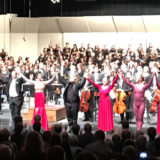By Tim Gaylard Special to The Roanoke Times
On Monday night, at the Taubman Museum of Art, the Roanoke Symphony Orchestra presented the final concert in its Destination Series. Featured musicians included the Roanoke Valley Children’s Choir, under the direction of Kim Davidson, and members of the orchestra — Julee Hickox on flute, John P. Smith on double bass and Roger Duvall on percussion, with David Stewart Wiley at the piano. The program, titled, “Angelic Voices — From Baroque & Broadway” was performed in front of an audience of 337.
The performing space, the atrium of the museum, had ideal live acoustics for the musicians. The eclectic program included Baroque works, traditional music, folk music, a pseudo-spiritual, pop and jazz standards, and a re-configured work by Wiley.
Because there were no program notes, Wiley gave welcome, informative and sometimes amusing introductions to most of the pieces. Davidson spoke only once, just before the last piece.
From the opening set of Baroque religious works, the chorus of almost 100 young people sang with perfect intonation, clear diction, a wide range of dynamics and a full sound. Davidson expertly led them with an energetic but precise conducting style. The results were quite often moving and thrilling.
The instruments greatly contributed to the overall effect. For example, Hickox played an evocative flute solo at the beginning of a very soulful performance of “Ose Shalom.”
Smith and Duvall provided a vibrant rhythm section for many of the pieces, and Wiley’s considerable talents as both a classical and jazz pianist were constantly on display.
But the real stars of the evening were the young sopranos and altos of the chorus. Their voices soared with the true joy of singing. When they sang Herbert Brewer’s “Magnificat” from memory, the music swelled to a thunderous conclusion.
An a cappella version of “Will the Circle Be Unbroken” started with a fine solo vocal trio, but gradually grew in texture and dynamics with all the singers participating, enhanced by syncopated clapping and a religious fervor that was truly breathtaking.
Wiley’s own “Concentric Circles,” originally an instrumental film score piece, was given well-written lyrics by Jim Sherman, who was in the audience, and was performed by all the musicians with great emotional intensity.
George Harrison’s “Here Comes the Sun,” in an a cappella arrangement, got a wonderfully choreographed version with head and hand gestures, culminating in the appearance of a painted sun on a placard, much to the delight of the audience.
The planned program ended with a bright and cheery rendition of “Old Mac Doodle Had a Band,” a beloved Ella Fitzgerald standard. This piece reached such an exciting and energizing ending, that the audience immediately rose for a standing ovation.
In response, the entire group performed a rousing rendition of the early rock ‘n’ roll classic “Rock Around the Clock.”
Timothy Gaylard is professor of music at Washington and Lee University.

